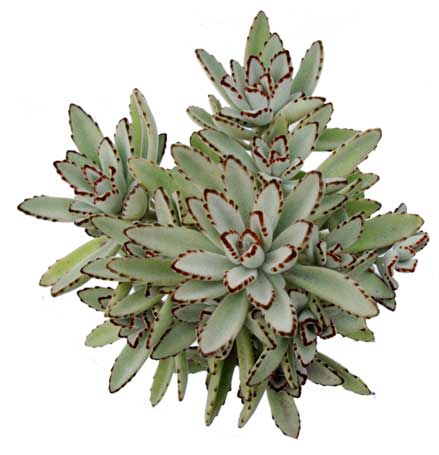|

Gen info
- Kalanchoe tomentosa, also known as pussy ears or panda plant, is a succulent plant in the genus Kalanchoe. It has many cultivars: Chocolate Soldier, Gold Girl, Black Tie, Teddy Bear.
- It has received the Royal Horticultural Society's Award of Garden Merit.
(6)
Botany
Panda is a perennial and succulent, low-growing
herb with stems and leaves densely covered with velvety white hairy
covering. Loose rosette of oval leaves are borne on woody stems. Leaves are soft, fleshy, grayish or silvery, oblong-obovate
and up to 7 centimeters long; margins have patches of orange on young leaves and dark brown on mature ones, and shallowly crenate towards
the upper portion.
 Distribution Distribution
- Introduced to the Philippines after WWII.
- Grows well in the Baguio area; cultivated as ornamental plant.
- Native to Madagascar.
Constituents
- Study of ethanolic extract for secondary metabolites isolated 14 compounds: α-amyrin acetate (1), friedelin (2), glutinol (3), 1-dotriacontanol (4), phytol (5),Stigmasta-7,25-dien-3β-ol (6), β-sitosterol (7), Isorhamnetin (8), 2,3-dihydroxypropyl tetradecanoate (9), eriodictyol (10), gallic acid (11), quercetin (12), kaempferol-3-O-Rutinoside (13) and isovitexin (14). (see study below) (3)
- Study of fresh leaves yielded flavonoid compounds viz., kaempferol (1), kaempferol 3-O-ß-D-glucopyranoside or astralgin (2) and kaempferol-3-O-α-L-rhamnoside or afzelin (3). (see study below) (5)
- Study of leaves isolated a cytotoxic bufadienolidic glycoside:
3β-(4′,6′-dideoxy-β-arabino-hexopyranosyloxy)-2β-acetoxy-5β,14β-dihydroxy-19-oxobufa-20,22-dienolide. (see study below) (7)
Properties
- Studies have suggested antioxidant, antimicrobial, cytotoxicity, anti-leukemic properties.
Uses
Folkloric
- No reported folkloric medicinal use in the Philippines.
- In Indonesian folk medicine, used for the treatment of fever, infections, rheumatism, and skin diseases. (5) Used for abscesses, bruises, contused wounds, cough. (8)
Studies
• Antioxidant / Cytotoxic / Antimicrobial: An ethyl acetate fraction showed the most potent radical scavenging on DPPH assay. The n-butanol fraction exhibited the highest cytotoxic activity against tested cell lines. Different crude extracts showed varying antimicrobial activity against most of the specific organisms tested. (see constituents above) (3)
• Toxicity Study: Leaves of Kalanchoe daigremontiana, K. tubiflora, K. fedtschenkoi, K. tomentosa, K. tomentosa X K beharensis and 4 cultivars of K. blossfeldiana were tested for toxicity on 2-week-old Leghorn chicks. Leaves of Kd, Kt, and Kf were toxic to chicks at dosage levels of 8 to 12 mg/g body weight. Kalanchoe tomentosa, Kt X K beharensis and 4 cultivars of Kb were nontoxic at the highest dosage levels tested. Alipathic nitro compounds and cyanogenic glycosides were not detected in any of the species. Alkaloids, nitrates, and soluble oxalates were present only in nontoxic concentrations. (1)
• Flavonoids / Cytotoxicity
Against Murine Leukemia Cells / Leaves: Study of fresh leaves yielded flavanoids kaempferol (1), astralgin (2), and afzelin (3). Compounds 1-3 showed cytotoxic activity against P-388 murine leukemia cells with IC50 of 51.8, >100, and 3.32 µg/mL, respectively. The ethyl acetate extract showed strongest cytotoxic activity. (see constituents above) (5)
• Bufadienolides / Leaves: Bufadienolides are a group of polyhydroxy C-24 steroids and their glycosides. Range of biological properties includes cytotoxic, antitumor, and cardiotonic activities. Study of leaves isolated a cytotoxic bufadienolidic glycoside, Kalachoside, 3β-(4′,6′-dideoxy-β-arabino-hexopyranosyloxy)-2β-acetoxy-5β,14β-dihydroxy-19-oxobufa-20,22-dienolide. (7)
• Cytotoxicity Against P-388 Murine Leukemia Cells / Flavonoids / Leaves: Methanolic extract of fresh leaves was concentrated and extracted successively with n-hexane, ethyl acetate, and n-butanol. The ethyl acetate extract exhibited strongest cytotoxic activity against P-388 murine leukemia cells. Column chromatography yielded a kaempferol-3-O-glycoside (1) and kaempferl-3-O-rhamnoside (2). Compounds 1 and 2 showed cytotoxic activity against P-388 murine leukemia cells with IC50 of >100 µg/mL and IC50 of 3.32 µg/mL, respectively. (8)
Toxicity concerns
• A blog reports all plant parts are poisonous if ingested.
• When tested for toxicity on 2-week old Leghorn chicks, Kalanchoe tomentosa, K tomentosa X K beharensis, and 4 cultivars of K. blossfeldiana were nontoxic at the highest dosage levels tested. (1)
Availability
Ornamental cultivation. |



 Distribution
Distribution

